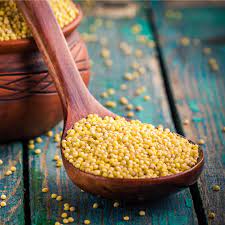
Millet grains have been a staple of our diet for ages. Millets, in addition to providing several health benefits, are also beneficial to the environment due to their minimal water and input requirements. The United Nations named 2023 the International Year of Millets at the request of the Government of India in order to raise awareness and promote production and consumption of millets. To mark the occasion, My Gov is presenting a variety of interactive activities in and around millets.
A nutritious source of protein, fibre, essential vitamins, and minerals is millet. The protection of cardiovascular health, delaying the onset of diabetes, assisting individuals in achieving and maintaining a healthy weight, and controlling intestinal inflammation are just a few of the potential health advantages of millet. Your health will improve if you consume millet on a regular basis. Post-menopausal women can use it to fend off heart conditions. Additionally, it could regulate the body’s high cholesterol and blood pressure. Since it contains fibre, those who have gallstones should also gain from it.There are good Grass seeds Beneficial or balanced grains include millet. These five millets—Kodo millet, Foxtail millet, Barnyard millet, Brown top millet, and Little millet—are regarded as positive millets because of their excellent nutritional value. Seed grasses known as millets (cereal crops) flourish in semi-arid tropical regions of Asia and Africa. It was first a widely consumed grain utilized as animal fodder that eventually spread throughout the world. Millets are warm-weather cereals that grow annually and have tiny grains linked to grass.
Although millet is a general name, there are different kinds of millets that you can find. Some of the most popular millets consumed by people, particularly in India, include jowar, bajra, ragi, etc. After a substantial change in food culture, people started to only eat gluten-free foods. Millets eventually became recognized for what they were after that pivotal change, and along with rice and wheat, they have become a staple diet in most families. The term “naked grains” refers to millets without a protective husk. These millets include Ragi, Jowar, and Bajra, as some examples. These are among the most widely grown types of grains because they don’t need to be processed after harvest. These include Fox millets, little millets, and Kodo millets. They are made up of an inedible seed covering. As a result, it is suggested that you remove the seed covering for eating. This mechanical procedure is typically utilized for rice.
Millets’ Health Advantages: Meals and beverages made from millet have practical and health-improving effects, such as advantages for the cardiovascular system, against diabetes, and against obesity. Additionally, millets include phytochemicals that strengthen the body’s immune system, including phenolics, sterols, lignans, inulin, resistant starch, -glucan, phytates, and tocopherol. Diabetes is a condition that affects millions of people worldwide. Millets are high in magnesium, which aids in the prevention of Type II diabetes. Magnesium is a necessary mineral that increases the productivity of insulin and glucose receptors by producing a large number of carbohydrate digesting enzymes that regulate insulin function.
Millets helps in Weight Loss: Millets are high in fibre and one of the most important sources of complex carbohydrates, according to various studies. As a result, they offer a variety of health benefits. It is now well acknowledged that consuming whole grains can aid in weight loss. Some researchers believe that the fibre and bioactive chemicals included in millets help us feel fuller for longer periods of time, lowering the need to snack between meals. As a result, it stimulates weight loss while maintaining nutritional levels.
Numerous readings have found that a high-fibre diet can help manage obesity. According to studies, eating high-fibre foods improves bowel function and lowers the incidence of obesity by growing digestion and absorption in the body, lowering the risk of chronic diseases. Furthermore, millets are low in calories and high in energetic nutrients such as carbs, proteins, amino acids, lipids, minerals, and vitamins, which aid in weight loss, according to several case studies.
Millets offer immune-boosting effects, according to research. They help to boost immunity and prevent illness. Millets contain iron, manganese, magnesium, phosphorus, potassium, copper, selenium, and zinc, all of which are necessary for the body’s proper functioning. Millets boost natural immunity to resist numerous ailments that can affect human health. These claims concerning millets are scientifically supported.
Benefits in cholesterol lowering and heart disease prevention: They protect against cardiovascular disease by decreasing triglyceride and high cholesterol levels. Furthermore, millets include monounsaturated fatty acids and a high concentration of vitamin E, which aid in the reduction of bad cholesterol and the prevention of heart disease. Millets are abundant in fibre in the diet and, according to some research, may be helpful for persons with heart problems. Millets contain approximately 75% carbohydrate by weight in their dietary fibre. As a result, it is neither absorbed nor digested in the tiny intestines but breaks down in the colon, providing some advantages to the gut.
Millets, India’s main food and the world’s third-largest cereal crop, are also a wonder treatment. According to a study, it is one of the most promising anti-cancer medications now available due to its ability to detoxify the body. Millets maintain a healthy digestive tract by stimulating the creation of hydrochloric acid and the beneficial bacteria essential for digestion, according to research. Furthermore, millets contribute in the production of pancreatic fluid, which is involved in digestion and metabolism.
To generate local and worldwide demand and to supply people with nutritious food, the Government of India suggested to the United Nations that 2023 be designated as the International Year of Millets. Millets are a good source of nutrition for well-being and if they are consumed daily in one’s meal; it is beneficial. Grass seeds are very healthy and a rich source of fibre. These help in reducing heart disease. Millets are also good for skin and bones.
Mandeep Singh is Assistant Professor, School of Hotel Management, Jaipur National University Rajasthan.













